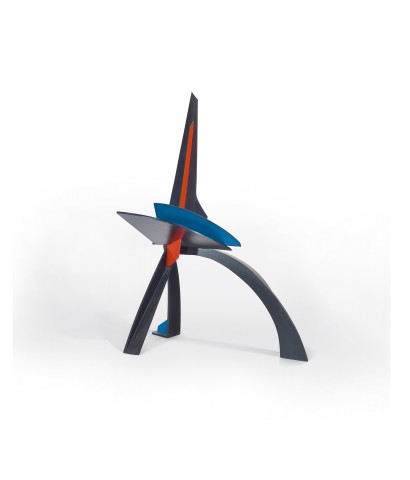PEGASUS, 1991
INGE KING
polychrome steel
124.0 cm height
signed at base: Inge King
Private collection, Perth, acquired directly from the artist, November 2003
Grishin, S., The Art of Inge King Sculptor, Macmillan Art Publishing, Melbourne, 2014, p. 37
Way back in 1966, the author, as a callow and wide-eyed student, visited Inge King’s studio-home in Melbourne’s outer suburb of Warrandyte. “The Kings”, as they were affectionately known, were a respected and dedicated couple. Even then it was clear that Grahame and Inge King’s devotion ran in two directions: one to the other and each to their own artistic practise. A rare, very fruitful and encompassing symbiosis seemed to energise their life and work. Their Robin Boyd designed home was brimming with artists’ prints, including Grahame’s, and Inge’s sculptures ran through the house, down into the studio and out in the garden. Here was a remarkable artistic life that was lived in and lived out. Everything had the warm look of being used rather than displayed; the atmosphere seemed patinaed by aesthetic activity.
Inge King’s sculptures are well-known and widely represented in various collections, especially in and around her native Melbourne. Her large Forward Surge at the Victorian Arts Centre and Sentinel on the EastLink Freeway spring immediately to mind. Then, of course, there are the major works at The University of Melbourne (Sun Ribbon), Heide Museum of Modern Art (Rings of Saturn), McClelland Sculpture Park and Gallery (Island Sculpture) and the National Gallery of Victoria (Rings of Jupiter III). An exhaustive listing is published in Emeritus Professor Sasha Grishin’s magisterial study: The Art of Inge King Sculptor of 2014.
King’s mature work Pegasus of 1991, created at the age of seventy-six, has a direct provenance and its unusual “windvane-like” format points to its extended sculptural significance. The visually striking steel sculpture has a beacon-like structure that uses a tripod base to support a series of forms suggesting the elongated mass of a body with an outstretched set of wings. The whole sits aloft a peak whose triangular outline is suggested by three large arcs. If the sculpture’s title is any guide the abstracted upper section of the sculpture may point to a link with the Greek myth of Pegasus, the winged horse upon the mountain of Helicon, a subject much favoured by the French artist Odilon Redon (1840-1916). Whatever the original ideational source, the sculpture’s three-dimensional format of held-aloft shapes atop a tripod base points to King’s later desire to “animate” and add “lift” to her sculptures during the early years of 2000, as exemplified by her contemporaneous Angel and Dance Series. If this is the credible case, the formal elements together with the arrested dynamism and gestalt of King’s Pegasus of 1991 may be seen as related to the overall “visual language” of Sentinel of 2000, her earlier and much-admired monumental commission (13 metres) for Melbourne’s EastLink Freeway.
Each of these two distinctive sculptures echo the transmutational processes that King’s creative mind so often employed. Considered in these ways, King’s Pegasus of 1991 presents as a rare and significant indicator of her main creative preoccupations during the early years of 2000; that is, how to combine cut-out forms and collage shapes into non-volumetric compositions that convincingly coax two-dimensional planar elements into three-dimensional masses.
KEN WACH
